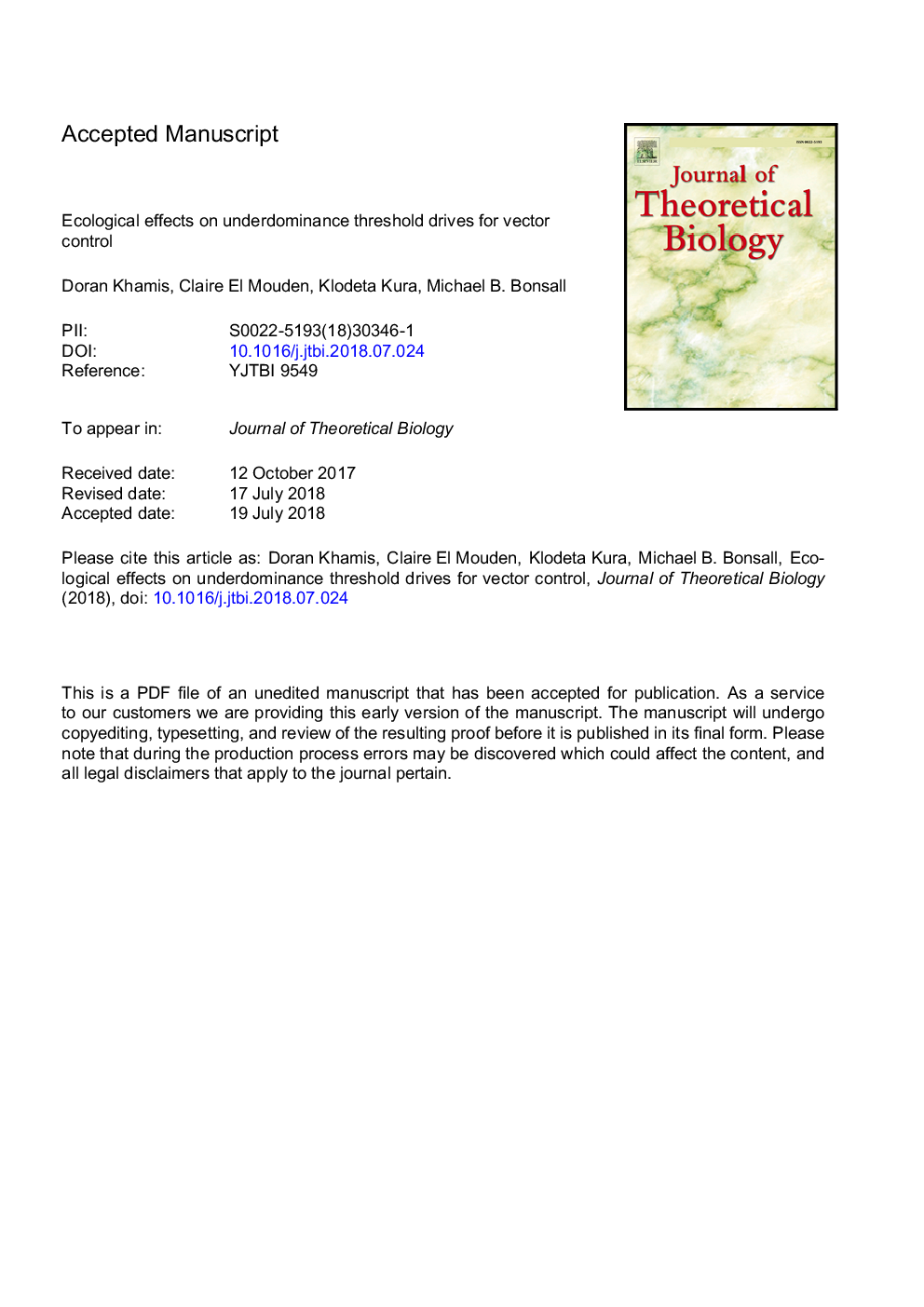| کد مقاله | کد نشریه | سال انتشار | مقاله انگلیسی | نسخه تمام متن |
|---|---|---|---|---|
| 8876426 | 1623754 | 2018 | 32 صفحه PDF | دانلود رایگان |
عنوان انگلیسی مقاله ISI
Ecological effects on underdominance threshold drives for vector control
ترجمه فارسی عنوان
اثرات زیست محیطی بر آستانه زیرزمینی برای کنترل
دانلود مقاله + سفارش ترجمه
دانلود مقاله ISI انگلیسی
رایگان برای ایرانیان
کلمات کلیدی
درایو ژنی، ژنتیک جمعیت، بوم شناسی، همهگیرشناسی، کنترل پشه
ترجمه چکیده
درایو ژن زیرزمینی، درایوهای وابسته به فرکانس است که هدف آن گسترش یک ژنوتیپ هموزیگوت مورد نظر در یک جمعیت است. هنگامی که هوموسیگوت مورد نظر در یک فرکانس آستانه آزاد می شود، معایب تناسب اندوتزیگوت به منظور حفظ رضایت مورد نظر عمل می کند. درایوهای تحت مداخله به عنوان راهی برای کنترل بیماری های برونشده از طریق سرکوب و جایگزینی جمعیت در مزایای فضایی و برگشت پذیر که مستقیما به نگرانی های امنیتی بالقوه در مورد درایوهای ژنی مربوط می شود، پیشنهاد شده است. در اینجا، دینامیک اکولوژیک و اپیدمیولوژیکی به یک مدل ژنتیک پشه ای مرتبط است تا به لحاظ نظری تاثیر نوع مختلف ژن زیرزمینی را بر شیوع بیماری بررسی کند. سیستم های ما با دو آلل مهندسی ساخته شده اند که بر روی یک جفت کروموزوم در یک مکان قرار گرفته اند و یا هموزیگوت بر روی جفت های مختلف در موقعیت های مختلف، مرگ و میر ژنتیکی است که بر روی هر دو جنس و یا تنها زنان تاثیر می گذارد، و تنها دو جنسی و یا مردان تنها منتشر شده است. علاوه بر این، هزینه های تناسب ژنتیکی و تناسب زیستی مختلفی که می توانند از اصلاح ژنتیکی و پرورش مصنوعی بوجود آیند، از طریق اثر آن بر فرکانس آستانه جمعیتی مورد نیاز برای ایجاد مکانیزم درایو مورد بررسی قرار می گیرند. ما نشان می دهیم که آزادی های مردانه باید به طور قابل توجهی بزرگتر از انتشار دو جنسی باشند تا باعث رانندگی کمرنگ شود. علاوه بر این، ما دریافتیم که مرگ و میر خاصی در زنان بیش از میزان مرگ و میر دو جنس، درصد بالاتری از موارد بیماری را در یک دوره کنترل از بین می برد. کاهش تناسب ژنتیکی هوموزیگوتهای مهندسی شده می تواند به طور قابل توجهی آستانه زیرزمینی را افزایش دهد، اما ما متوجه می شویم که موفقیت پیوند پشه های ترانس ژنیک با زنان وحشی (تحت تأثیر کمبود رقابت یا تکامل مقاومت رفتاری در شکل فعال زنان اولویت مات) و طول عمر پشه های مصنوعی پرورش برای اهداف موفقیت در تلاش های کنترل رانندگی مبتنی بر سرپرستی بسیار مهم است.
موضوعات مرتبط
علوم زیستی و بیوفناوری
علوم کشاورزی و بیولوژیک
علوم کشاورزی و بیولوژیک (عمومی)
چکیده انگلیسی
Underdominance gene drives are frequency-dependent drives that aim to spread a desired homozygote genotype within a population. When the desired homozygote is released above a threshold frequency, heterozygote fitness disadvantage acts to drive the desired trait to fixation. Underdominance drives have been proposed as a way to control vector-borne disease through population suppression and replacement in a spatially contained and reversible way-benefits that directly address potential safety concerns with gene drives. Here, ecological and epidemiological dynamics are coupled to a model of mosquito genetics to investigate theoretically the impact of different types of underdominance gene drive on disease prevalence. We model systems with two engineered alleles carried either on the same pair of chromosomes at the same locus or homozygously on different pairs at different loci, genetic lethality that affects both sexes or only females, and bi-sex or male-only releases. Further, the different genetic and ecological fitness costs that can arise from genetic modification and artificial rearing are investigated through their effect on the population threshold frequency that is required to trigger the drive mechanism. We show that male-only releases must be significantly larger than bi-sex releases to trigger the underdominance drive. In addition, we find that female-specific lethality averts a higher percentage of disease cases over a control period than does bi-sex lethality. Decreases in the genetic fitness of the engineered homozygotes can increase the underdominance threshold substantially, but we find that the mating success of transgenic mosquitoes with wild-type females (influenced by a lack of competitiveness or the evolution of behavioural resistance in the form of active female mate preference) and the longevity of artificially-reared mosquitoes are vitally important to the success chances of underdominance based gene drive control efforts.
ناشر
Database: Elsevier - ScienceDirect (ساینس دایرکت)
Journal: Journal of Theoretical Biology - Volume 456, 7 November 2018, Pages 1-15
Journal: Journal of Theoretical Biology - Volume 456, 7 November 2018, Pages 1-15
نویسندگان
Doran Khamis, Claire El Mouden, Klodeta Kura, Michael B. Bonsall,
